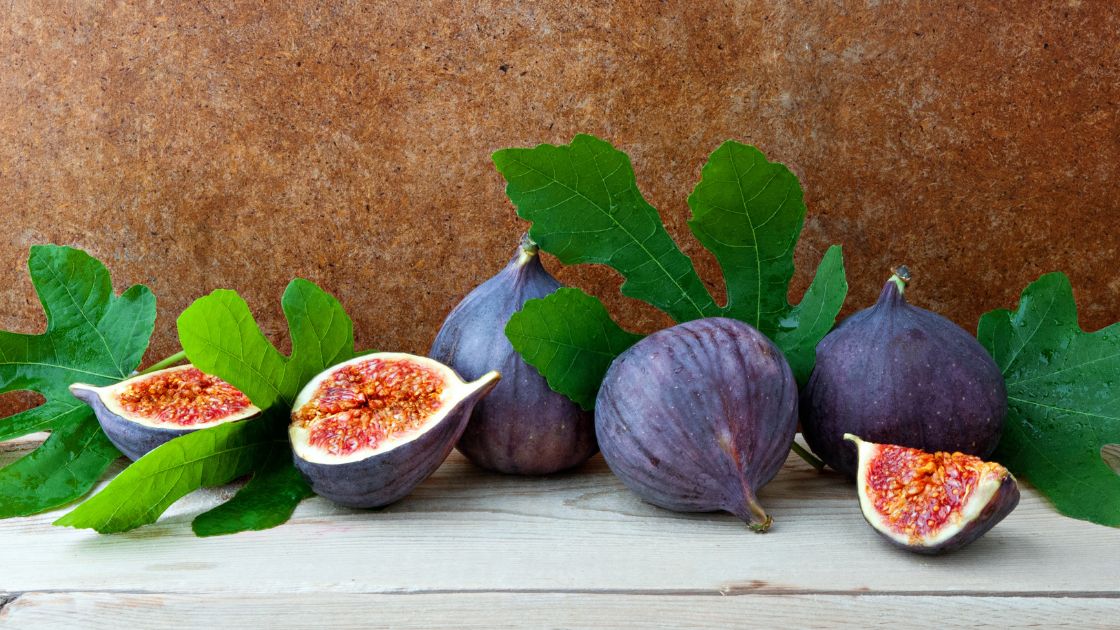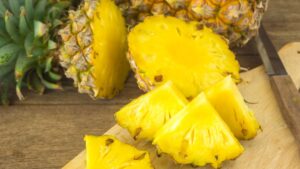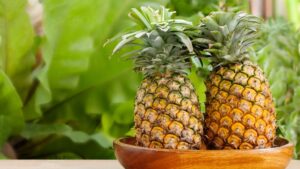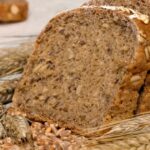Did you know that figs are such a nutritious fruit that Olympic athletes ate in ancient Greece?
Well yes, its high nutritional value has made medicine consider it one of the healthiest and most nutritious fruits.
So figs, in addition to their sweetness and flavor, are medicinal and have a large number of benefits.
Keep reading and learn with us everything related to figs. Its origin, production, nutritional value, benefits, and recipes to consume it.
Physical description
The fig tree is a little tree that resembles a shrub, it can grow to a height of ten meters. The fig tree is distinguished from the others by its long, deeply lobed leaves.
Figs have a distinct flavor that is sweet, soft, and crunchy all at once. They also have thin skin and a variety of colors, the most popular of which are green, purple, blue, and black. A fig’s flesh is typically red, and the whole fruit can be eaten.
History and production
The fig was a particularly well-liked meal in ancient Greece. According to legend, this fruit was even Plato’s favorite, earning it the moniker “the fruit of the philosophers.”
Though it is thought that its origins are more likely to be found in Western Asia. Through the Mediterranean, the Phoenicians and the Greeks in what is now Palestine and Asia Minor brought the fig to Europe.
Around 1.15 million tons of figs are produced each year worldwide. Most production is concentrated in Asia Minor and the Mediterranean region, which has the biggest consumption.
Turkey is the world’s largest fruit producer, producing 305,689 tons of fruit annually, or 27% of the total tonnage.
Its high production and consumption are due to the great nutritional value of this fruit. Read on to find out what they are.
Nutrients of FigsÂ

Copy this code and paste on your website:
<a href="https://nutripurpose.com/figs/"><img style="width:100%;" src="https://nutripurpose.com/wp-content/uploads/2023/02/Figs.png"></a><br>Read More <a href="https://nutripurpose.com/figs/">Fig</a>A healthy diet should include fresh figs because they are a fantastic source of nutrients and have few calories.
One fresh small (40-gram) fig includes the following nutrients:
- 30 Calories
- 8 grams of Carbs
- 0 grams of Fat
- 0 grams of Protein
- 1 gram of Fiber
- 3% of the Daily Value (DV) of Copper
- 2% of the DV of Potassium
- 2% of the DV of Magnesium
- 2% of the DV of Thiamine
- 2% of the DV of Riboflavin
- 2% of the DV of Vitamin K
- 3% of the DV of Vitamin B6
Eating a few fresh figs makes a reasonable, low-calorie snack. It can also be eaten as a complement to a meal.
Although it contains few calories from natural sugar, the sugar is concentrated in the dried fig. This makes them a fruit with a high sugar and calorie content.
Figs have small amounts of numerous minerals but are especially rich in copper and vitamin B6.
Copper is an essential mineral necessary for the creation of blood cells, connective tissues, and neurotransmitters. It is also necessary for metabolism and energy production in the body.
Our body needs vitamin B6 to digest the proteins in food and make new proteins. Furthermore, it has a significant impact on brain health.
Thanks to these nutrients present in the fig we can obtain many benefits for our health. Continue reading and learn what they are.
Figs health benefits

May encourage wholesome skin
Figs can have some positive effects on the skin. Especially for those who suffer from allergic dermatitis or dry, itchy skin caused by allergies.
A cream made from dried fig extract was found to be beneficial in 45 children with dermatitis. It was more effective in curing the symptoms of the condition than the hydrocortisone cream that is the usual treatment.
Additionally, a combination of fruit extracts, including fig extract, have been shown to have antioxidant effects on skin cells. It also reduces the breakdown of collagen and decreases the appearance of wrinkles according to studies.
Has potential cancer-fighting abilities
On the impact of fig leaves on cancer cells, numerous encouraging test-tube experiments have been carried out.
Fig leaves and the natural latex produced by fig plants have been shown to inhibit cancer. Especially human colon cancer, breast cancer, cervical cancer, and liver cancer cells.
However, this does not imply that consuming figs has the same benefits. More studies are required to determine how the consumption of figs or fig leaves influences the development of cancer.
Can potentially aid in blood sugar control
Drinking fig leaf tea can reduce the amount of insulin in people with type 1 diabetes according to a study. Their insulin doses dropped by about 12% during the month they drank fig leaf tea.
Another study found that drinks with high concentrations of fig extract had a lower glycemic index (GI) than drinks without fig extract. This indicates that these drinks would have a more beneficial impact on blood sugar levels.
Dried figs are high in sugar and can temporarily raise blood sugar levels. Therefore, it is recommended to limit the intake of dried figs. Especially if you have difficulty controlling your blood sugar levels.
Foster good digestive health
For years, people have used figs as a natural medicine or as an alternative treatment for digestive problems like constipation.
They include fiber, which can help promote digestive health by softening and bulking up your stool. They reduce constipation and act as a prebiotic or food source for beneficial bacteria in the intestine.
Fig paste has been shown in animal experiments to speed up the passage of food through the digestive tract. It also relieves the symptoms of gastrointestinal diseases, including ulcerative colitis.
A study conducted on 150 people who ate approximately 4 dried figs saw a significant improvement in their discomfort. They suffered from bloating, constipation, and moderate gastrointestinal problems.
Additionally, a trial of 80 people indicated that supplementation dramatically reduced constipation in people with this condition. The dose of 10 ounces of fig paste per day for eight weeks was found to be highly effective.
Broccoli, bananas, spinach, and asparagus are good sources of fiber that can be complemented with fig consumption.
Anything else I should know about figs?
Of course. You must know how to eat them. Here are some alternatives for you to try at home.
Figs recipes
Especial Fig Salad

Time preparation: 10 minutes
Servings: 4
Ingredients:
- 30g of cheese (select the cheese of your choice)
- 12 ripe figs (cut by the middle)
- 1tablespoon of pink peppercorns
- 3 tablespoons of olive oil
- 1 tablespoon of white wine vinegar
Procedure:
- On a plate, place the figs cut side up.
- Mix the remaining ingredients, excluding the pink peppercorns.
- Add a small amount of freshly hot water, then mix again to create an emulsion.
- Pour the dressing over the figs and top with the crushed peppercorns.
Easy Fig Cookies

Time preparation: 20 minutes
Servings: 10 cookies
Ingredients:
- 100g of unsalted butter
- 100g of flour
- 150g soft of sugar
- 1 tablespoon of baking powder
- 100g of rolled oats
- 8 figs (cut in the middle in lengthways)
- 1 tablespoon of milk
- ½ tablespoon of bicarbonate of soda
- ½ tablespoon of salt
Procedure:
- Turn oven on to 180°C/160°F.
- Use electric mixers to mix the butter and sugar until extremely light and fluffy.
- Add to the mixture the flour, the oats, the baking powder, the bicarbonate of soda, the salt, and finally the milk.
- Using a sharp knife, make a thin slice the length of each fig half starting at the stem end. Do it from the top so the slices stay together and can be spread out.
- Shape the dough into balls and place them on a baking sheet lined with parchment paper.
- Flatten the top of each cookie down a bit to make room for a fig half. With the cut side up, place the fig halves.
- Bake for approximately 12 to 15 minutes.
Once you taste the figs you will be fascinated like Elizabeth David:
“To eat figs off the tree in the very early morning, when they have been barely touched by the sun, is one of the exquisite pleasures of the Mediterranean.”
Eat figs and sweeten your palate
Without a doubt, figs have many benefits to offer. This fruit rich in fiber and calcium may be the food you need to help strengthen your body. Remember that if you suffer from diabetes you should consult your doctor and eat it in moderation.

I am a professional health and nutrition writer with extensive experience in the industry. My passion for sharing valuable insights on nutrition and wellness stems from over 15 years of personal training and maintaining a healthy lifestyle. My commitment to continuously educate myself on the latest trends and research in the field allows me to deliver high-quality content that is informative and engaging. My mission is to empower individuals to make informed decisions about their health and well-being through my writing.









